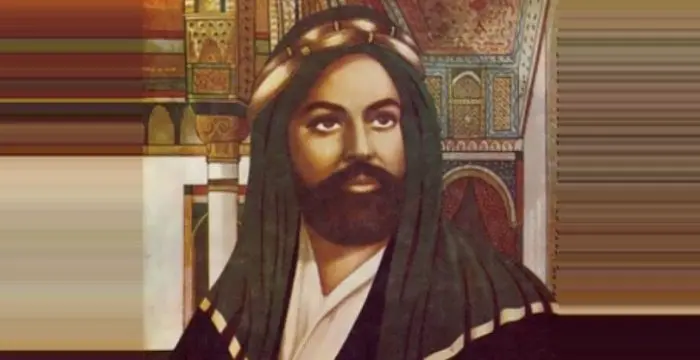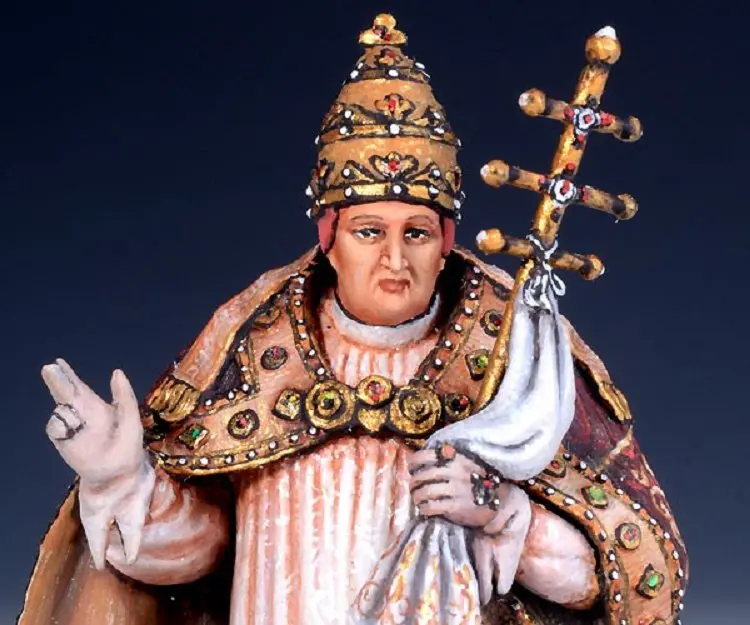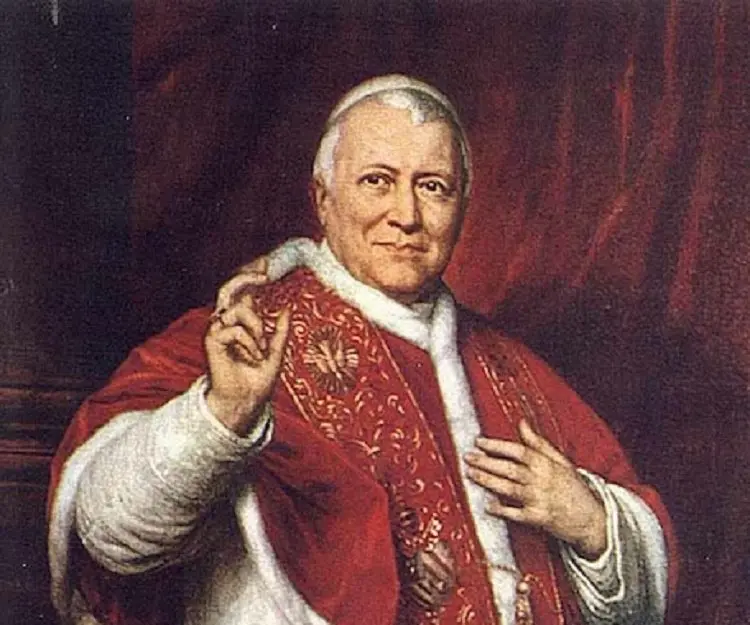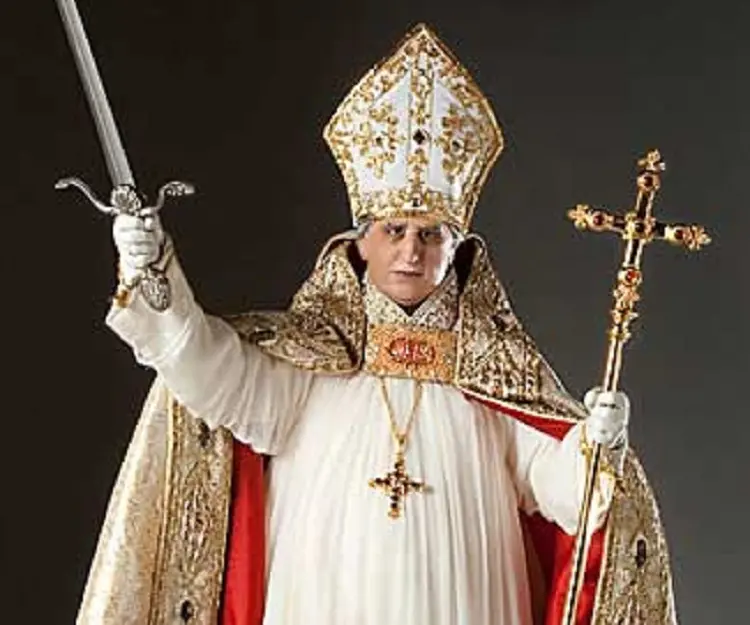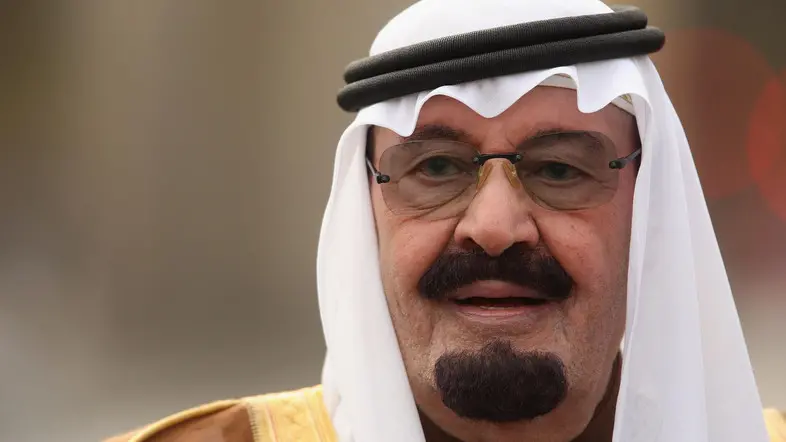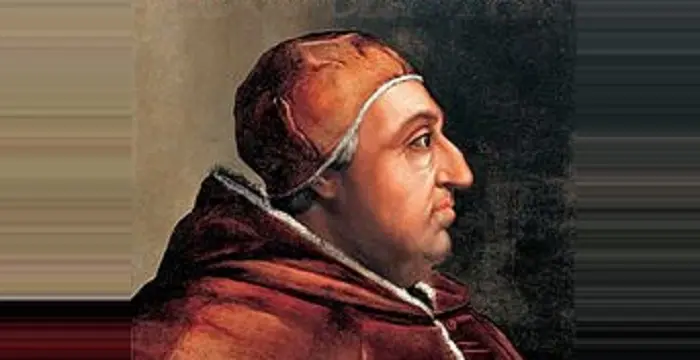
Pope Alexander VI - Kings, Career and Personal Life
Pope Alexander VI's Personal Details
Pope Alexander VI was the Spanish-born 214th Pope
| Information | Detail |
|---|---|
| Birthday | January 1, 1431 |
| Died on | August 18, 1503 |
| Nationality | Italian |
| Famous | Historical Personalities, Emperors & Kings, Emperors, Kings, Religious Leaders |
| Known as | Rodrigo de Borja y Doms, Rodrigo Borgia |
| Childrens | Cesare Borgia, Lucrezia Borgia |
| Birth Place | Xàtiva, Spain |
| Gender | Male |
| Sun Sign | Capricorn |
| Born in | Xàtiva, Spain |
| Famous as | Religious Leader |
| Died at Age | 72 |
// Famous Religious Leaders
Prophet Muhammad
Prophet Muhammad was the founder of Islam, one of the most widespread religions in the world. This biography profiles his childhood, life story, achievements and more.
Murad IV
Murad IV was one of the mighty Sultans in the history of the Ottoman Empire. This biography profiles his childhood, family, accession, rule, administration and timeline.
Eckhart Tolle
Eckhart Tolle is a well-known spiritual leader, and author. Check out this biography to know about his childhood, family, personal life, spiritual awakening, etc.
Pope Alexander VI's photo
Who is Pope Alexander VI?
Rodrigo de Borja y Doms (Italian: Rodrigo Borgia) was the Spanish-born 214th Pope who was raised to the papal chair as Pope Alexander VI. He is one of the most controversial figures in the history of papacy. He hailed from the house of Borgia which was a prominent and powerful Italo-Spanish noble family during the Italian Renaissance with several members who served in administrative positions in the Catholic Church. Under the supervision of his uncle, Alonso de Borgia, the Bishop of Valencia, Rodrigo studied law and graduated as a doctor of ecclesiastical law. After Alonso’s election as Pope Callixtus III, he was ordained successively as a bishop, cardinal, and vice-chancellor of the Church. He served under four other pontiffs, amassing immense power and wealth. In 1492, following the death of Pope Innocent VIII, Borgia emerged as the Pope with an unprecedented show of coercion and corruption, and held the office until his death in 1503. Despite working tirelessly for the unification of the Christendom, his reforms of the Curia, and the diligent patronage of art and education, his legacy has been marked by venality, nepotism, libertinism, and quite a few accusations of murder. Historians often attribute the subsequent rise of Protestantism to his disregard of the spiritual inheritance of the Catholic Church.
// Famous Emperors
Sundiata Keita
Sundiata Keita was the founder of the Mali Empire in West Africa. This biography profiles his childhood, early life, struggles, founding of empire, rule, administration, achievements and also gives some fun facts.
Ashoka
Ashoka was the third emperor of the Mauryan Dynasty and ruled almost the entire Indian subcontinent. This biography profiles his childhood, life, reign, achievements and timeline
Murad IV
Murad IV was one of the mighty Sultans in the history of the Ottoman Empire. This biography profiles his childhood, family, accession, rule, administration and timeline.
Childhood & Early Life
Rodrigo was born on January 1, 1431, in the town of Xàtiva near Valencia, a component realm in the Kingdom of Aragon, which is now in Spain, to parents Jofré Llançol i Escrivà and Isabel de Borja y Cavanilles. His parents were distant cousins.
According to an alternative theory, his father’s name is considered to be Jofré de Borja y Escrivà, which would make him part of Borgia clan from both sides of the family. The veracity of this is highly unlikely, as all his children were known to be of Llançol paternal lineage.
He was an exemplary student. He enrolled at the ‘University of Bologna’ to study law. His uncle, Alonso de Borgia, as the Bishop of Valencia, oversaw his nephew’s education. He graduated as “the most eminent and judicious jurisprudent” as a doctor in ecclesiastical law.
Priesthood
Rodrigo went to Rome to join Alonso after the latter became a cardinal. His rise through the clerical hierarchy was meteoric. After Alonso’s coronation as Pope Callixtus III on April 8, 1455, Rodrigo took up his mother’s family name, realising new prospects for his ambition. He was made the Bishop of Valencia soon after, a post recently vacated by his uncle.
In an act of nepotism quite characteristic of that age, Alonso showered Rodrigo with many rich benefices. At 25, he was made deacon and then Cardinal-Deacon of San Nicola in Carcere. He would hold the post till 1471. He was appointed as the administrator of Girona in 1457. The same year, he became the Vice-Chancellor of the Holy Roman Church.
Although Pope Callixtus III died in 1458, it barely hindered Borgia’s power and influence in the Church. For 30 years, he served under five different popes – his uncle Callixtus III, Pius II, Paul II, Sixtus IV and Innocent VIII – all the while living like a prince, accumulating administrative experience and wealth.
His ordination to the priesthood took place in 1468 and three years after that, he was anointed as a bishop and was elected as the Cardinal-Bishop of Albano. In 1476, he was chosen as the Cardinal-Bishop of Porto and the Dean of the Sacred College.
He was named the first Archbishop of Valencia after his proposal of making the city a metropolitan see, submitted 16 days prior to the death of Innocent VIII, was granted. The position was handed down within the Borgia family, first ‘inherited’ by his son Cesare, the second Archbishop of Valencia and then by Juan de Borja and Pedro Luis de Borja, the third and fourth Archbishops of Valencia, respectively.
Tenure as Pope
Some changes in the constitution of the College of Cardinals were brought about in the 15th century, particularly during the tenures of Sixtus IV and Innocent VIII. There were 27 cardinals at the tail end of the reign of Innocent VIII, out of whom at least 10 were cardinal-nephews, eight were nominated by various rulers across Christendom, four were Roman nobles, and one received cardinalate due to his family’s years of service to ‘Holy See.’ Only four rose through the clerical ranks.
There were three primary candidates for the papacy following the death of Innocent VIII on July 25, 1492—Ascanio Sforza for the Milanese, Giuliano della Rovere from the pro-French faction and Borgia, who was perceived as an independent candidate. There were speculations that Borgia had bought out majority of the votes, even bribing Sforza with four mule-loads of silver. Either way, the 1492 conclave was an expensive campaign all around.
On August 11, 1492, at 61 years of age, Rodrigo was elevated as Pope Alexander VI. In the initial years after assuming papacy, he maintained the strict administration of justice and orderly government. Soon, however, he started to bestow lands, power, and wealth to his relatives. Besides making his illegitimate son Cesare the Cardinal of Valencia at 18, he appointed 11 other cardinals, and gave his other sons Giovanni the Spanish Dukedom of Gandia, and Gioffre several fiefs out of the Papal States.
He issued three ‘Bulls of Donation’, also known as the ‘Alexandrine Bulls’, to grant overseas territories to Portugal and Spain. ‘Eximiae devotionis’ was issued on May 3, 1493, ‘Inter caetera’ on May 4, and ‘Dudum siquidem’ on September 26.
In 1494, Charles VIII of France invaded Italy to seize the throne of Naples. Alexander was threatened with deposition and convocation of a reform council. Politically isolated in his country, he sought help from Bayezid II, the Sultan of Turkey.
He met the French monarch in 1495, when he was given the traditional obeisance due to him from a French ruler. Eventually, he forged an alliance with Venice, Milan, and the Holy Roman emperor to drive the French out of Italy.
His favourite son, Giovanni or Juan, was murdered on June 14, 1497. Grief stricken, Alexander launched an investigation to find the murderer. It would not be until much later that Cesare would be suspected of the crime.
Many serious historians have accused Alexander and Cesare of poisoning Cardinal Adriano Castellesi. However, there is no clear evidence to support the claim. There are only confessions extracted from Alexander’s servants, but those were given under severe torture, supervised by Julius II, a life-long enemy of Alexander.
He demonstrated great fortitude in handling the Girolamo Savonarola situation. Savonarola was a Florentine Dominican Friar who usurped political control in Florence in 1494 and put forward invectives against papal corruption. He was ultimately put to death by the government of his city.
He set up a new tradition of opening a holy door on Christmas Eve and closing it on Christmas Day the following year in the Jubilee Year 1500. He also managed to subjugate the two most powerful families of Rome, Orsini and Colona, in the last years of his papacy.
On August 6, 1503, Alexander and Cesare had dinner with Adriano Castellesi and a few days later, they both fell ill. While Cesare eventually recovered, the 72-year-old Pontiff did not. He died on August 18. As the body was extremely disfigured by rapid decomposition, it was exhibited the next day while being covered by an old tapestry.
Administrative Policies
Due to his other activities, the reforms Alexander VI brought about in the increasingly irresponsible Curia are often overlooked. He created a group of the most pious cardinals in the Church to help the process move along more swiftly. Some of the changes he intended to implement were the new rules on the sale of the Church property, restricting cardinals to one bishopric, and stricter moral code for clerics. If he had lived longer, perhaps with the actualization of these plans, he would have received a better assessment from history.
As a well-known patron of art, he hosted Bramante, Raphael, Michelangelo, and Pinturicchio in Rome. His apartment in the Apostolic Palace in the Vatican was lavishly painted by Pinturicchio. He loved theatre as well; Plautus’ ‘Menaechmi’ was often performed in his papal suite.
He encouraged the development of education within Christendom. He issued a papal bull, founding King’s College, Aberdeen, upon a petition from William Elphinstone, Bishop of Aberdeen, and King James IV of Scotland. He signed a bill of approval for the ‘University of Valencia’ in 1501.
Personal Life & Legacy
Contemporary sources state that in his youth, Borgia was a handsome man with a very cheerful countenance and genial bearing. He was charming and eloquent, and beautiful women were attracted to him. He was a capable and intelligent leader, viewed as a ‘political priest’ by many. A gifted orator, his speeches demonstrated a comprehensive knowledge of the scriptures. He was also an ardent supporter of the further development of arts and sciences.
Alexander VI had several mistresses, the most prominent of whom was Vannozza dei Cattanei. Their relationship is believed to have begun sometime between 1466 and 1472 and lasted through her three marriages. She bore him four children, Cesare (born 1475), Giovanni (1476), Lucrezia (1480), and Gioffre (1482).
In the immediate years leading to his elevation to the papacy, Borgia’s passion for her somewhat waned, though he maintained that his love for her was “spiritual”. Before acknowledging Vannozza’s children as his, he pretended that they were his niece and nephews, fathered by her husbands. As Pope, he legitimized each of them as his own, spending vast amount of money and resources on them.
Another of his important mistresses was the wife of Orsino Orsini, Giulia Farnese. Orsino was related to Borgia through his mother Adriana, who was his cousin. Adriana was put in charge of Lucrezia, who was often visited by her father at the Orsini estate. In one of these visits, he met Giulia and immediately sought permission from her mother-in-law to have her as a mistress. Adriana agreed to the arrangement and in return Orsino was granted the mayorship of Carbognano.
Their affair produced a daughter, Laura, born in 1492. Fearing a scandal might break out in the very year of his ascension as the pope, he let the paternity be attributed to and accepted by Orsini. It is very possible that Giulia had other children by him. After 1500, she fell out of favour with the Pope and an amicable separation was reached with Adriana’s help.
He had four other children whose paternity he acknowledged but there had been no mention of their mothers. They are Girolama, Isabella, Pedro-Luiz, and Bernardo.
He is an ancestor of the queen consort Luisa María Francisca de Guzmán y Sandoval of Portugal, wife of King John IV. Through her, he is the ancestor of most Southern and Western European royal houses.
As a priest, he received a severe reprimand from Pope Pius II for his riotous mode of life. After Borgia’s death, Pope Pius III served as 215th Pope only for 26 days before his death on October 18, 1503. He was succeeded by Julius II.
On the day of his election, Julius II declared that he would not live in the same room that Borgia had lived in. He ordered all the tombs of the Borgias to be opened, and the bodies sent to Spain. The Borgia apartments were left sealed till the 19th century.
One of the things that set Alexander VI apart in papal history of that period is his benign treatment of the people of Jewish faith. He welcomed about 9000 destitute Iberian Jews into the Papal States after their expulsion from Spain in 1492. He also provided safe passage to immigrating Jews who were expelled from Portugal in 1497 and from Provence in 1498. Della Rovere even accused him of being a Marrano.
Trivia
His last words before death were “I'll come, I'll come. It's normal for you to call me. But wait a bit more”.
Two of his successors, pontiffs Sixtus V and Urban VIII, had hailed him as one of the most outstanding popes since Saint Peter.
// Famous Kings
Sundiata Keita
Sundiata Keita was the founder of the Mali Empire in West Africa. This biography profiles his childhood, early life, struggles, founding of empire, rule, administration, achievements and also gives some fun facts.
Ashoka
Ashoka was the third emperor of the Mauryan Dynasty and ruled almost the entire Indian subcontinent. This biography profiles his childhood, life, reign, achievements and timeline
Murad IV
Murad IV was one of the mighty Sultans in the history of the Ottoman Empire. This biography profiles his childhood, family, accession, rule, administration and timeline.
Pope Alexander VI biography timelines
- // 1st Jan 1431Rodrigo was born on January 1, 1431, in the town of Xàtiva near Valencia, a component realm in the Kingdom of Aragon, which is now in Spain, to parents Jofré Llançol i Escrivà and Isabel de Borja y Cavanilles. His parents were distant cousins.
- // 1457In an act of nepotism quite characteristic of that age, Alonso showered Rodrigo with many rich benefices. At 25, he was made deacon and then Cardinal-Deacon of San Nicola in Carcere. He would hold the post till 1471. He was appointed as the administrator of Girona in 1457. The same year, he became the Vice-Chancellor of the Holy Roman Church.
- // 1458Although Pope Callixtus III died in 1458, it barely hindered Borgia’s power and influence in the Church. For 30 years, he served under five different popes – his uncle Callixtus III, Pius II, Paul II, Sixtus IV and Innocent VIII – all the while living like a prince, accumulating administrative experience and wealth.
- // 1466Alexander VI had several mistresses, the most prominent of whom was Vannozza dei Cattanei. Their relationship is believed to have begun sometime between 1466 and 1472 and lasted through her three marriages. She bore him four children, Cesare (born 1475), Giovanni (1476), Lucrezia (1480), and Gioffre (1482).
- // 1476His ordination to the priesthood took place in 1468 and three years after that, he was anointed as a bishop and was elected as the Cardinal-Bishop of Albano. In 1476, he was chosen as the Cardinal-Bishop of Porto and the Dean of the Sacred College.
- // 1492There were three primary candidates for the papacy following the death of Innocent VIII on July 25, 1492—Ascanio Sforza for the Milanese, Giuliano della Rovere from the pro-French faction and Borgia, who was perceived as an independent candidate. There were speculations that Borgia had bought out majority of the votes, even bribing Sforza with four mule-loads of silver. Either way, the 1492 conclave was an expensive campaign all around.
- // 1492On August 11, 1492, at 61 years of age, Rodrigo was elevated as Pope Alexander VI. In the initial years after assuming papacy, he maintained the strict administration of justice and orderly government. Soon, however, he started to bestow lands, power, and wealth to his relatives. Besides making his illegitimate son Cesare the Cardinal of Valencia at 18, he appointed 11 other cardinals, and gave his other sons Giovanni the Spanish Dukedom of Gandia, and Gioffre several fiefs out of the Papal States.
- // 1492Their affair produced a daughter, Laura, born in 1492. Fearing a scandal might break out in the very year of his ascension as the pope, he let the paternity be attributed to and accepted by Orsini. It is very possible that Giulia had other children by him. After 1500, she fell out of favour with the Pope and an amicable separation was reached with Adriana’s help.
- // 1492One of the things that set Alexander VI apart in papal history of that period is his benign treatment of the people of Jewish faith. He welcomed about 9000 destitute Iberian Jews into the Papal States after their expulsion from Spain in 1492. He also provided safe passage to immigrating Jews who were expelled from Portugal in 1497 and from Provence in 1498. Della Rovere even accused him of being a Marrano.
- // 1493He issued three ‘Bulls of Donation’, also known as the ‘Alexandrine Bulls’, to grant overseas territories to Portugal and Spain. ‘Eximiae devotionis’ was issued on May 3, 1493, ‘Inter caetera’ on May 4, and ‘Dudum siquidem’ on September 26.
- // 1494In 1494, Charles VIII of France invaded Italy to seize the throne of Naples. Alexander was threatened with deposition and convocation of a reform council. Politically isolated in his country, he sought help from Bayezid II, the Sultan of Turkey.
- // 1494He demonstrated great fortitude in handling the Girolamo Savonarola situation. Savonarola was a Florentine Dominican Friar who usurped political control in Florence in 1494 and put forward invectives against papal corruption. He was ultimately put to death by the government of his city.
- // 1495He met the French monarch in 1495, when he was given the traditional obeisance due to him from a French ruler. Eventually, he forged an alliance with Venice, Milan, and the Holy Roman emperor to drive the French out of Italy.
- // 1497His favourite son, Giovanni or Juan, was murdered on June 14, 1497. Grief stricken, Alexander launched an investigation to find the murderer. It would not be until much later that Cesare would be suspected of the crime.
- // 1500He set up a new tradition of opening a holy door on Christmas Eve and closing it on Christmas Day the following year in the Jubilee Year 1500. He also managed to subjugate the two most powerful families of Rome, Orsini and Colona, in the last years of his papacy.
- // 1501He encouraged the development of education within Christendom. He issued a papal bull, founding King’s College, Aberdeen, upon a petition from William Elphinstone, Bishop of Aberdeen, and King James IV of Scotland. He signed a bill of approval for the ‘University of Valencia’ in 1501.
- // 18th Aug 1503On August 6, 1503, Alexander and Cesare had dinner with Adriano Castellesi and a few days later, they both fell ill. While Cesare eventually recovered, the 72-year-old Pontiff did not. He died on August 18. As the body was extremely disfigured by rapid decomposition, it was exhibited the next day while being covered by an old tapestry.
// Famous Emperors & Kings
Sundiata Keita
Sundiata Keita was the founder of the Mali Empire in West Africa. This biography profiles his childhood, early life, struggles, founding of empire, rule, administration, achievements and also gives some fun facts.
Ashoka
Ashoka was the third emperor of the Mauryan Dynasty and ruled almost the entire Indian subcontinent. This biography profiles his childhood, life, reign, achievements and timeline
Murad IV
Murad IV was one of the mighty Sultans in the history of the Ottoman Empire. This biography profiles his childhood, family, accession, rule, administration and timeline.
Xerxes I
Xerxes I (Xerxes the Great) was the fourth and the most famous king of the Archaemenid dynasty of Persia. This biography profiles his childhood, family, personal life, life history, achievements, campaigns, administration, death and other facts.
Sargon of Akkad
Sargon of Akkad, also called ‘Sargon the Great’, ‘Sarru-Kan’ and ‘Shar-Gani-Sharri’, was the founder and first king of the Akkadian Empire. This biography profiles his childhood, life, rule, administration, timeline, and gives some fun facts.
Abdullah of Saudi Arabia
Abdullah bin Abdulaziz Al Saud was the King of Saudi Arabia from 2005 to 2015 and the third wealthiest head of state in the world. Find more facts about his life, childhood and timeline.
Pope Alexander VI's FAQ
What is Pope Alexander VI birthday?
Pope Alexander VI was born at 1431-01-01
When was Pope Alexander VI died?
Pope Alexander VI was died at 1503-08-18
Which age was Pope Alexander VI died?
Pope Alexander VI was died at age 72
Where is Pope Alexander VI's birth place?
Pope Alexander VI was born in Xàtiva, Spain
What is Pope Alexander VI nationalities?
Pope Alexander VI's nationalities is Italian
Who is Pope Alexander VI childrens?
Pope Alexander VI's childrens is Cesare Borgia, Lucrezia Borgia
What is Pope Alexander VI's sun sign?
Pope Alexander VI is Capricorn
How famous is Pope Alexander VI?
Pope Alexander VI is famouse as Religious Leader
